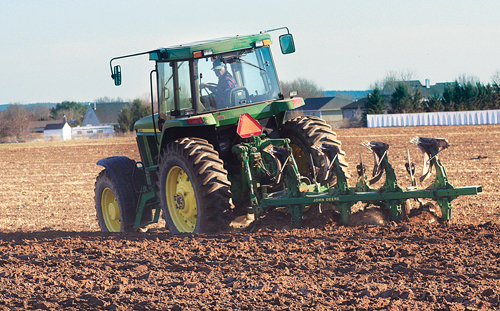Farmers take part in program to cut use of water-polluting fertilizers

Growing sweet corn on the North Fork is an art form. It takes time, attention and plenty of fertilizer to ensure crops have enough nutrients to thrive.
The results are delicious, but the process can cause unintended harm to the environment, namely pollution from nitrogen that seeps into ground and surface water and feeds damaging algal blooms.
In an effort to achieve a successful harvest while protecting the environment, Suffolk County farmers are participating for the second year in a conservation project this summer to reduce their use of nitrogen fertilizers on sweet corn and potato crops. The technology, called controlled-release fertilizer, is designed to break down gradually according to the plant’s need for nutrients. The product would replace conventional fertilizers that can dissolve during heavy rains and enter local water systems.
Cornell Cooperative Extension and American Farmland Trust are spearheading the water-quality improvement project. CCE is working directly with 35 farmers to calibrate equipment to apply fertilizers at the correct rate. To test the product’s efficiency, samples will be taken from corn and potato crops produced with traditional fertilizer and controlled-release nitrogen fertilizer to determine if both crops are receiving adequate nitrogen, according to AFT.
“Long Island farmers are well aware of concerns about drinking water, as well as Long Island Sound and the Peconic estuary,” said David Haight, New York director of AFT. “Our project offers practical ways for farmers to sustain crop yields while reducing nitrogen entering the water.”
Last year’s program had 10 participating farmers, who were able to cut their fertilizer use by an average of 20 percent while sustaining farm productivity, according to AFT.
Marty Sidor, owner of North Fork Potato Chips in Cutchogue, said the product fits well in his planting and fertilizing plan.
“It’s very user-friendly,” Mr. Sidor said. “I have seen crops that store better and I have not seen one deficiency in the field through all this time.”
Fourth-generation farmer Phil Schmitt, owner of Schmitt Family Farm in Riverhead, is having similar success with the conservation methods.
“We practice very intensive agriculture,” he said. “We started to see that the land was getting a little tired.”
To regenerate the soils, Mr. Schmitt employs an integrated pest management approach to reduce his use of pesticides and spreads compost to reduce the need for synthetic fertilizers. As a part of this initiative, Mr. Schmitt is using controlled-release nitrogen fertilizer on all of his sweet corn.
He made the switch, he said, “to do the right thing.”
To encourage participation, the program provides risk protection for farmers interested in reducing dependence on traditional fertilizers, but concerned about possible yield losses. The farmland trust and AgFlex, a private company that manage the risks farmers face when adopting conservation practices, introduced the protection policy to 10 Suffolk sweet corn growers in 2012. It pays farmers cash if a new conservation practice, such as switching to a controlled-release nitrogen fertilizer, reduces yields — and therefore income.
Becky Wiseman, CCE’s agricultural environmental stewardship coordinator who works with farmers on the program, said it addresses water contamination, one of the toughest issues local farmers have ever faced. The region’s aquifers, the sole source of drinking water, as well as Long Island Sound and the Peconic estuary, suffer from heightened levels of nitrogen, according to the farm trust.
Suffolk County long ago recognized that safeguarding agriculture involves safeguarding agricultural lands. Suffolk launched the country’s first farmland preservation program in the 1970s. Before that, aggressive real estate development reduced land in active farming from 100,000 acres during the mid-1900s to the current 34,000 acres. Without the action, Long Island would have lost nearly all of its farms, Mr. Haight said.
Today, agriculture is the backbone of the region’s economy. Suffolk County ranks first in New York in annual farm sales, with more than $300 million in farm products sold in 2010, according to the trust.
“We hope Suffolk County will once again be a national leader by demonstrating that it’s possible to work with farmers to protect water quality while keeping farms economically viable,” Mr. Haight said.







